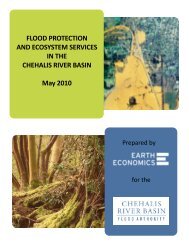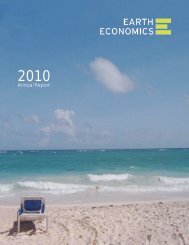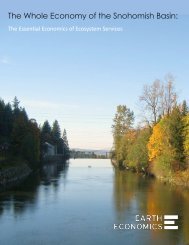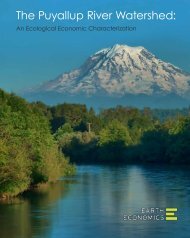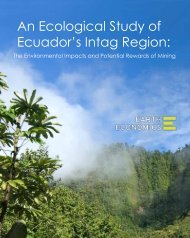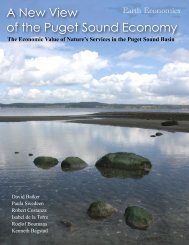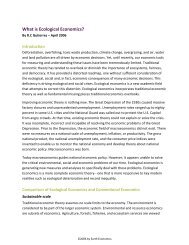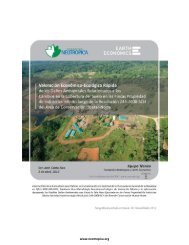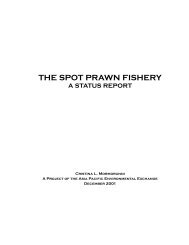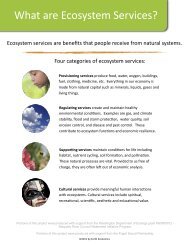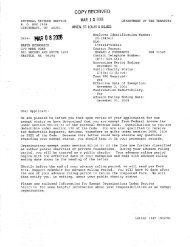Puget Sound: Washington State's Best Investment - Earth Economics
Puget Sound: Washington State's Best Investment - Earth Economics
Puget Sound: Washington State's Best Investment - Earth Economics
Create successful ePaper yourself
Turn your PDF publications into a flip-book with our unique Google optimized e-Paper software.
<strong>Investment</strong> Opportunity<br />
Our <strong>Puget</strong> <strong>Sound</strong> economy is built upon the land and<br />
waters of the <strong>Puget</strong> <strong>Sound</strong> Basin, where 1.6 million<br />
people, 70% of <strong>Washington</strong> State’s population, work,<br />
live, and play. 1<br />
Nearly 71% of all jobs and 77% of total<br />
income in <strong>Washington</strong> State are found<br />
in the <strong>Puget</strong> <strong>Sound</strong> Basin. 2<br />
Fourteen out of twenty-three identified ecosystem<br />
goods and services provided by nature within the<br />
Basin provide benefits worth over $10 billion in<br />
value every year. If the basin were treated as an<br />
economic asset that provides this annual flow of<br />
goods and services, the asset value of the <strong>Puget</strong><br />
<strong>Sound</strong> Basin would be between $300 billion and $2.6<br />
trillion. 3 Even at the low end of this estimate, the<br />
value of natural systems in the <strong>Puget</strong> <strong>Sound</strong> Basin is<br />
enormous. Yet this wealth is being lost. 3<br />
The key to securing ecological sustainability,<br />
employment, and economic prosperity is investment.<br />
Today’s investment in <strong>Puget</strong> <strong>Sound</strong> determines the<br />
physical nature of <strong>Washington</strong> State’s economy<br />
tomorrow. As built capital has become more common<br />
and natural capital more scarce, natural capital has<br />
increased in relative value. Thus the returns from<br />
investing in natural capital have also risen. Investing<br />
in the health of <strong>Puget</strong> <strong>Sound</strong> has a higher rate of<br />
return on investment (ROI) and more certain return<br />
than most built capital investments.<br />
As the ecological health of the <strong>Puget</strong><br />
<strong>Sound</strong> Basin improves or deteriorates,<br />
benefits provided by natural systems<br />
for free and potentially in perpetuity<br />
will rise or fall to the benefit or<br />
detriment of <strong>Washington</strong> State’s<br />
economy.<br />
Lessons from Chesapeake<br />
Much like <strong>Puget</strong> <strong>Sound</strong>, Chesapeake Bay is a regional<br />
economic and ecological backbone. The Bay is home<br />
to residents, recreation, commercial and military<br />
ports, and historically important (though declining)<br />
commercial fisheries. 4 Chesapeake Bay is also the<br />
largest estuary in the contiguous United States,<br />
providing a wealth of ecosystem services. 5<br />
Forty Years of Recovery Efforts<br />
The states of Virginia, Maryland, and Pennsylvania,<br />
and the District of Columbia, have promoted<br />
Chesapeake recovery for the past forty years.<br />
In the mid 1970s, studies showed pollution was<br />
increasing due to growing agricultural application<br />
of fertilizers and chemicals, population density,<br />
and sewage treatment plant discharge. 6 In 1976,<br />
the Environmental Protection Agency (EPA) began<br />
examining nutrient over-enrichment, influx of toxic<br />
substances, and the decline in submerged vegetation.<br />
The Chesapeake Bay Agreement of 1983 aligned the<br />
recovery efforts of the three surrounding states, the<br />
federal government, and the District of Columbia. 7<br />
This agreement helped set the goals for recovery<br />
at the actual systems scale of the problem across<br />
jurisdictional boundaries and enabled coordinated<br />
action to solve common problems. One finds many<br />
parallels to the challenges now faced by the multijurisdictional<br />
context of <strong>Puget</strong> <strong>Sound</strong>.<br />
The Chesapeake 2000 Plan was showcased as a<br />
model of ecosystem-based management, but so far<br />
the results of the plan’s implementation have been<br />
mixed; moderate advances have been achieved in<br />
some areas, while declines have continued in others.<br />
Points of failure in the Chesapeake 2000 Plan can be<br />
attributed in part to misalignment of state agency<br />
goals and measurements. 8<br />
6



